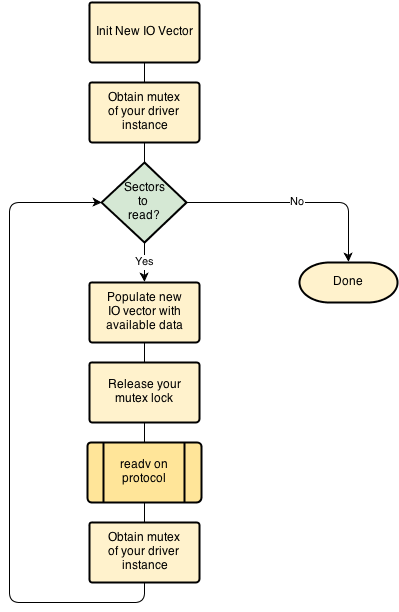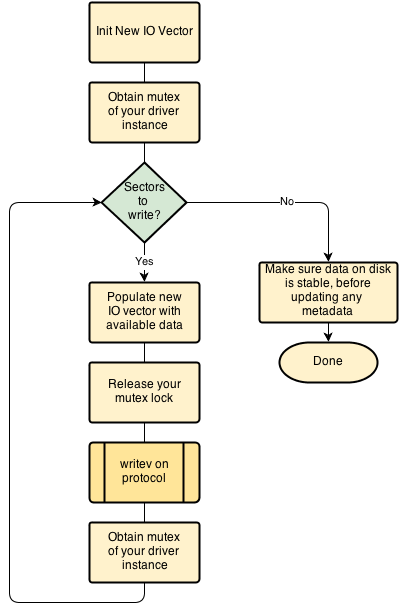Implementing New Block Drivers
A QEMU Developer Primer
Jeff Cody
Red Hat, Inc.
First, some background on Block Drivers
What Is A Block Driver?
A QEMU block driver provides storage on the host, that the guest sees as a drive.
In the QEMU code, they are located in the block/ directory.
The two major block driver types in QEMU
- Image format drivers
- Protocol based drivers
Image Format Drivers
Provide a structured way to store data, often with built-in features (such as snapshots, data sparseness, drive metadata, etc..).
Examples
- QCOW2
- QED
- raw
- etc.
Protocol based drivers:
Provides the underlying data I/O for image formats, although may also be a stand-alone driver as well.
Examples include:
Network-based protocols drivers in QEMU:
- Gluster
- iSCSI
- NBD
- etc.
Host protocols drivers in QEMU:
- raw-posix files
- raw-posix host devices
- etc.
The BlockDriver struct
The BlockDriver struct contains the block-layer internal API to the format driver. It consists mainly of function pointers, used to interface with the driver.
.bdrv_open.bdrv_co_readvetc..
We'll get into these more later.
Core Concepts
- Probing
- Open and Reopen
- Coroutines, and Read / Write
- Metadata Caching
- Image Creation
- Data Handling
- Backing Files
- Testing
The Probe
00000000 76 68 64 78 66 69 6c 65 51 00 45 00 4d 00 55 00 |vhdxfileQ.E.M.U.|
00000010 20 00 76 00 31 00 2e 00 36 00 2e 00 35 00 30 00 | .v.1...6...5.0.|
00000020 00 00 00 00 00 00 00 00 00 00 00 00 00 00 00 00 |................|
00000000 51 46 49 fb 00 00 00 02 00 00 00 00 00 00 00 b8 |QFI.............|
- If first 2K is not enough, probe won't work.
- Return a confidence score from 0-100.
The Probe
static int qcow2_probe(const uint8_t *buf, int buf_size, const char *filename)
{
const QCowHeader *cow_header = (const void *)buf;
if (buf_size >= sizeof(QCowHeader) &&
be32_to_cpu(cow_header->magic) == QCOW_MAGIC &&
be32_to_cpu(cow_header->version) >= 2)
return 100;
else
return 0;
}
The BlockDriver Open Flow
(Simplified view, as relevant to an Image Format Driver)

Let's Jump In
Implementing a (very basic!) Image Format Driver
Creating a new format - the "silly" format
At the minimum, we need:
- block_init(), for our driver to be seen
- To define our BlockDriver, and register it via bdrv_register()
- A format name (ours is "silly")
- In our BlockDriver, we must at least have a .bdrv_open() implementation
Let's see this as code.
#include "block/block_int.h"
/* Our open function */
static int silly_open(BlockDriverState *bs, QDict *options, int flags,
Error **errp)
{
return 0;
}
/* Our attributes / functions */
static BlockDriver bdrv_silly = {
.format_name = "silly",
.bdrv_open = silly_open
};
/* register our BlockDrivers */
static void bdrv_silly_init(void)
{
bdrv_register(&bdrv_silly);
}
/* macro magic, creates an init function */
block_init(bdrv_silly_init);
Your Driver's Stateful Data
Most Block Drivers require state data, populated on open.
- Provided via BlockDriverState .opaque field
- Size is specified in BlockDriver struct, .instance_size
- Not allocated by your driver, but by the block layer
The BlockDriverState struct is passed to most functions. The "opaque" field is for your driver's internal data.
What your open must provide
At a minimum, your .bdrv_open must:
- Verify the integrity of the image, if relevant
- Populate your internal state data ("opaque")
- Total sectors, if relevant for your driver
Reopen functionality
Reopen allows QEMU to open an image chain with different flags
- Live snapshots
- Block commit
- etc..
Reopen has three hooks:
- Prepare (.bdrv_reopen_prepare)
- Commit (.bdrv_reopen_commit)
- Abort (.bdrv_reopen_abort)
Reopen functionality
.bdrv_reopen_prepare(), required if reopen supported
- Returns 0 for success - stub OK
- Protocols will likely have more to do
Depending on what your driver needs to support reopen, you may also need to provide the commit and abort functions, but these are optional
Coroutines, and Read / Write
Block driver read / write operations all make use of coroutines
What are coroutines?
Coroutines allow asynchronous code to masquerade as synchronous code
(Despite sounding complex, this makes life easier for you!)
Control stays with your coroutine until you either yield, or return
How does my driver use coroutines?
- Take CoMutex when needed (
qemu_co_mutex_lock) - Yield if needed (
qemu_coroutine_yeild()) - Everything uses coroutines
The BlockDriver Read Flow
Simplied read flow, for an Image Format driver using I/O vectors

The BlockDriver Write Flow
Simplied write flow, for an Image Format driver using I/O vectors

Metadata Caching
This can cause problems
During Live Migration, the image format metadata may differ from your cache.
Metadata Cache Flushing
You can either invalidate the metadata when requested, or prevent migration
- .bdrv_invalidate_cache()
- migrate_add_blocker()
BlockDriver Image File Creation
- Implement .bdrv_create()
- Define QEMUOptionParameter
- Don't trust it
- Do pack it
- Do convert endian
- We don't want to allocate more memory than expected (DoS)
- We don't want to read / write past buffers (overflows)
- We don't want to crash QEMU
- Use QEMU_PACKED on structures read/written from disk
- Convert endiannes for on-disk fields
- But maybe not other systems
- Populate bs->backing_file
- Implement
.bdrv_co_get_block_status - Use qemu-iotests
- Create test in tests/qemu-iotests
- Bash or Python
- Put test in 0##, and expected output in 0##.out
- Sample Images
- For a compatibility driver, test against source
Sample BlockDriver Struct
static BlockDriver bdrv_qcow2 = {
.format_name = "qcow2",
.instance_size = sizeof(BDRVQcowState),
.bdrv_probe = qcow2_probe,
.bdrv_open = qcow2_open,
.bdrv_close = qcow2_close,
.bdrv_reopen_prepare = qcow2_reopen_prepare,
.bdrv_create = qcow2_create,
/* snipped */
.bdrv_co_readv = qcow2_co_readv,
.bdrv_co_writev = qcow2_co_writev,
.bdrv_co_flush_to_os = qcow2_co_flush_to_os,
/* more snipped */
.create_options = qcow2_create_options,
};
Data Handling
If you are reading or writing data structures from / to disk, please:
Don't Trust That Data
Unvalidated data can be security risks:
Packing and Endian conversion
Make sure that your driver will work on all platforms
If you don't do this, your driver may work fine on your system.
Backing Files
Testing
There is much more!
Look at BlockDriver struct in include/block/block_int.h